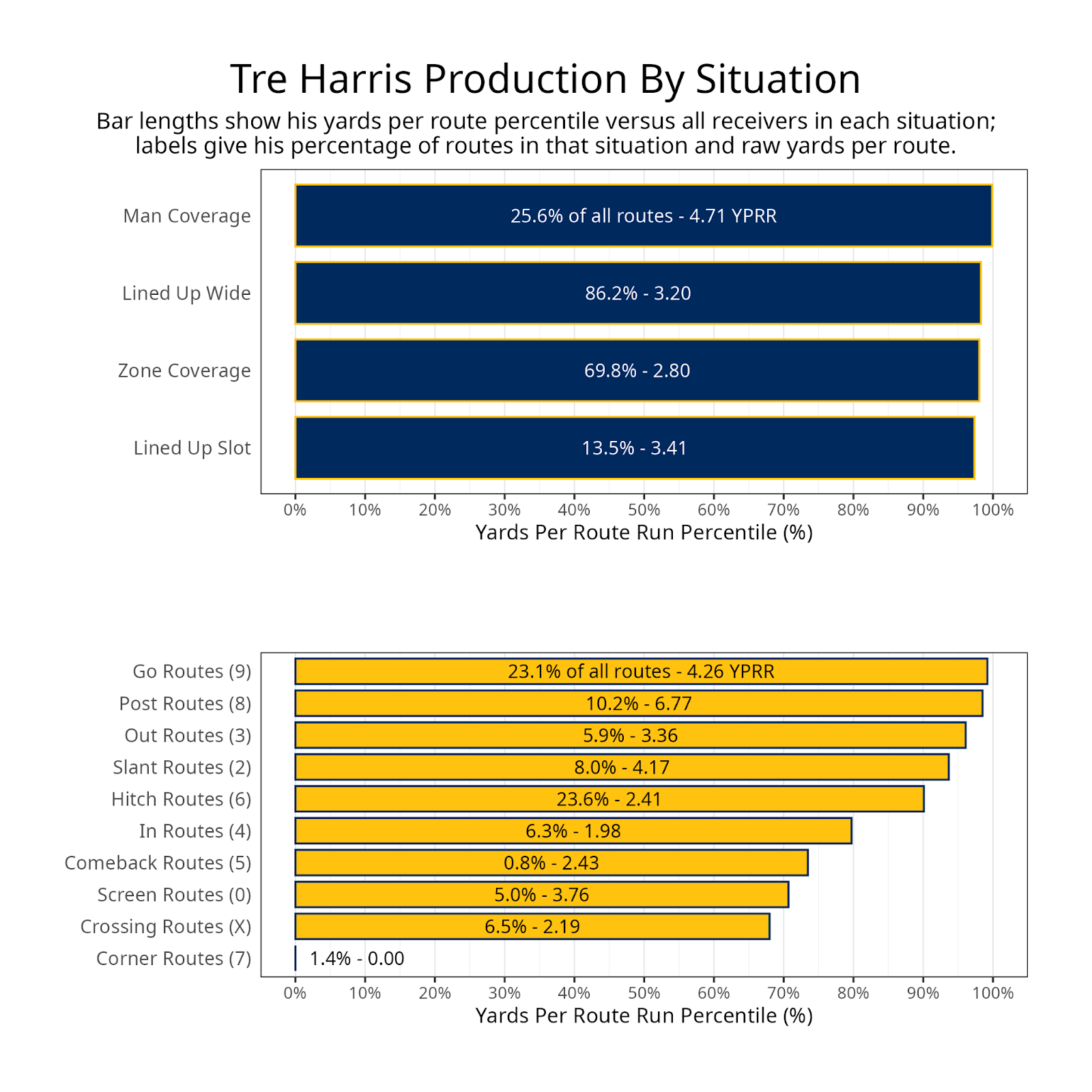- Tre Harris was consistent before injury: Harris averaged 5.12 yards per route run in his final season, but his year was cut short due to injury.
- Justin Herbert’s potential favorite deep target: Harris was one of the top deep threats while at Ole Miss, and Los Angeles lost their biggest deep target in free agency.
- Final chance to claim 25% off PFF+: Use code DRAFT25 and unlock access to player grades, fantasy tools and the 2025 Draft Guide.
Estimated Reading Time: 5 minutes

PFF’s Fantasy Football Player Profile series delivers the most in-depth fantasy football analysis available for the 2025 season.
Using PFF’s exclusive data, we evaluate player performance, competition for touches and how teammates and coaching staffs will impact each player's fantasy football outlook.
Last updated: 7:15 a.m. Friday, May 2
Click here for more draft tools:
NFL Draft Big Board | Mock Draft Simulator | NCAA Premium Stats
2025 PFF Draft Guide | Mock Draft Hub | Prospect Data Profiles
Draft Position Rankings
Player performance
Tre Harris spent his first three seasons as a wide receiver for Louisiana Tech, playing a minimal role in 2020, a part-time role in 2021, and then assuming a more full-time role in 2022. He transferred to Mississippi in 2023, where he was the third wide receiver in routes run, but the clear top receiver in receiving grade. He failed to make an impact in some of their bigger games, such as against Alabama and Georgia. Still, he dominated other SEC opponents, including 213 yards against Texas A&M and 153 yards against LSU.
Last season, he was part of a four-man rotation over the first seven weeks before a hip and groin injury cut short his season. He tried to return later in the season but only made one more reception. Harris started the year completely dominating in non-conference play, averaging 157 yards per game. His PFF receiving grade took a noteworthy dip against SEC play, but he still gained at least 80 receiving yards in his three complete games.
Harris was one of the best deep threats in college football over the last two seasons. His 675 receiving yards on deep passes over the past two regular seasons ranked sixth-best among all Power-Five receivers, despite missing significant time last season. He was on pace to finish second behind Tetairoa McMillan. Our draft guide similarly focused on his ability to go deep, including that he “does well to get vertical” and “he can keep a defense honest with his field-stretching ability.”


Projected role
Harris lands with the Los Angeles Chargers, where he can ideally earn the Z receiver spot in three receiver sets. Ladd McConkey is locked into the Z receiver role in two-receiver sets and the slot in three-receiver sets. Both Quentin Johnston and Mike Williams are likely fighting for the X receiver spot. While Harris is capable of playing the X role, he would be better off filling in for Joshua Palmer.
Palmer was the Chargers' closest thing to a deep threat last year. While it’s not common for a player to play X in a base offense and Z in three receiver sets, it’s possible Harris can beat out both Johnston and Williams for base snaps.
Harris’ fantasy value could be dependent on his ability to diversify his route tree. Our draft guide compared him to Alec Pierce, a wide receiver with a high average depth of target but low target rate, who can keep the defense honest and make life easier for the underneath receivers. Pierce and receivers like him have minimal fantasy value, because they’ll have three or four games per season where they make multiple deep catches and have a big week but have minimal fantasy impact the rest of the weeks. Harris may have that kind of role in Los Angeles’ offense. However, with a more diverse route tree, Harris could potentially reach a 20% target rate and be a weekly fantasy starter.


Impact of teammates
Harris joins Greg Roman’s offense, which looked very different in 2024 compared to his past teams. In Baltimore and San Francisco, Roman ran a run-heavy offense, frequently using one- or two-receiver sets. The Chargers didn’t have the running backs to run that kind of offense effectively last season. Los Angeles added Omarion Hampton and Najee Harris at running back, Tyler Conklin at tight end and Mekhi Becton on the offensive line, which should allow them to run more often and be more diverse with their personnel groupings. This means we could see an offense that resembles the 2022 Baltimore Ravens more than the 2024 Chargers. Hollywood Brown’s best fantasy seasons occurred in Roman’s offense, and it’s possible Harris could fill a similar role.
Harris will benefit from catching passes from Justin Herbert, who is one of the most accurate passers, including on deep passes. He threw the ball deep more often last season than in past years, which led to the second-most deep passing yards and a tie for the most deep passing touchdowns. He accomplished this without a wide receiver ranked top 20 in deep receiving yards. Harris will allow Herbert to throw even more, giving Harris a decent chance of finishing among the top-20 wide receivers in deep receiving yards.


Bottom line
The Chargers drafted Harris, which boosted his fantasy value. He’s very likely to make an impact on the Los Angeles offense as a rookie, but he will need to catch both short and deep passes in order to become a fantasy starter.
Footnotes
- Statistics in tables and charts were chosen based on their ability to predict future fantasy performance on a per-game or per-opportunity basis or to describe the player relative to others at the same position.
- “Opportunities” are defined as passing dropbacks, rushing attempts and routes run as a receiver.
- Numbers are provided either by season or based on the past three years. For rookies, only college statistics are included. For non-rookies, only NFL statistics are considered, regardless of whether they played in college within the previous three years.
- As college competition is easier than NFL competition, most rookies are likely to see a decline from their historical numbers.
- Only FBS data is considered for college players and comparisons.
- Kneel-downs are removed from rushing data to provide cleaner quarterback rushing rate statistics.
- The table colors in this article range from blue (indicating good/high) to red (indicating bad/low).
- All percentiles and color codings compare the given player to others with a high sample of opportunities. Generally, the cutoff is one-third of the possible opportunities in the sample. If a player does not meet the threshold, they are still included in the comparison, though their results may appear better or worse than expected due to the smaller, less predictive sample size.
- Information on utilization classifications and their importance can be found here for running backs, wide receivers and tight ends.



 © 2025 PFF - all rights reserved.
© 2025 PFF - all rights reserved.